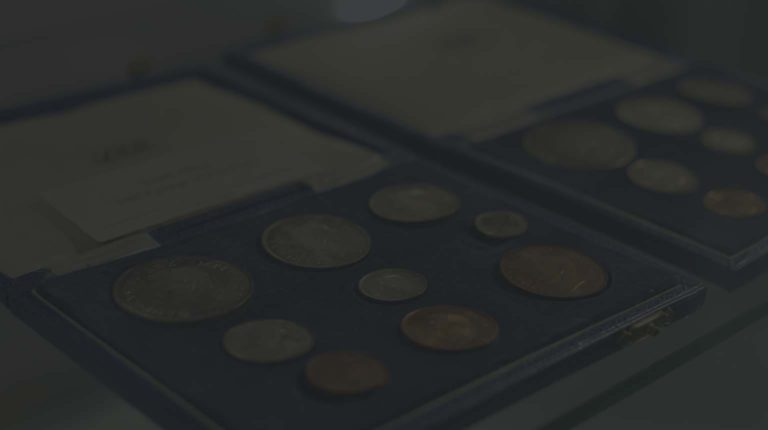Deciphering a coin can seem like a daunting task, especially for beginners. There is frequently used terminology that you may or may be aware of, and it might be difficult to recognise what it is that you’re looking at. Understanding the coin that sits in your hand, whether it be milled or hand-struck is a huge part of interpreting in the culture, technology and even politics at the time of those who created it. What do the patterns mean? What does the text say? By looking a little closer at some famous coins, we can crack the codes and discover the fascinating stories behind the money. We’re going to look at 3 ancient coin examples to begin breaking down those complex visuals.
The Basics
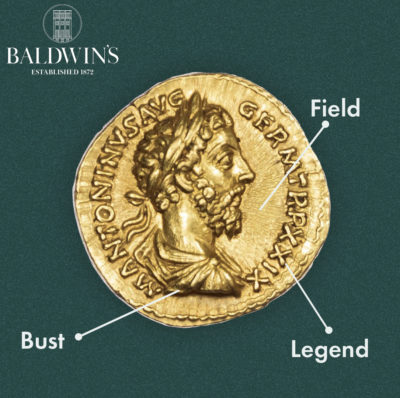
Constantius II (AD 337-361), Silver Siliqua
Obverse
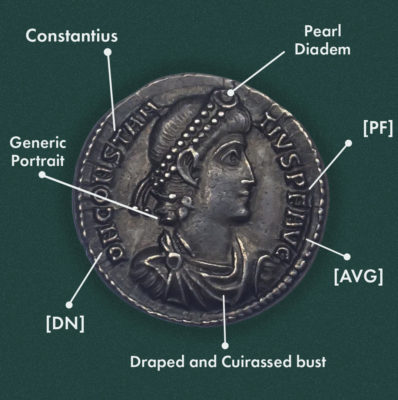
The Legend: Throughout history, coins have needed to convey lots of information on very small surfaces, words in the legend are often abbreviated. This coin reads:
- [DN] Dominus Noster, the Latin translation for ‘Our Lord’. This once controversial title was, by the 4th Century AD, a common motif across Roman coinage. The Roman people were generally against anyone referring to themselves as ‘lord’. However during the reign of Diocletian, the position of the emperor as supreme lord was well established.
- Constantius, the emperor.
- [PF] Pius Felix, meaning ‘pious’ (devoutly religious), happy’.
- [AVG] Augustus, relating to Emperor Augustus. All emperors after Augustus claimed authority from him and used his name ‘Augustus’ as a title – including on coins.
Portraiture:
- The Generic Portrait. By this period of Roman history the artistic style of Roman emperors show little evidence of Individuality.
- Draped and Cuirassed bust. Cuirassed busts became very common features of coins struck during the 3rd Century – a period of military emperors and turmoil in the empire. The tradition continued into the 4th Century, with emperors reminding the masses of their military might through this subtle feature.
- Pearl Diadem – The diadem appeared as an icon of the emperor during the 4th Century AD. Originally a Hellenistic royal object. The diadem may have re-emerged as a result of Constantine’s shift of Roman Power from West to East.
Reverse
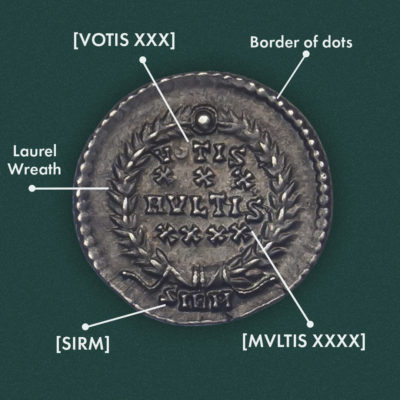
Inscriptions:
- [VOTIS XXX] Prayers for the 30th Anniversary. An ‘X’ meaning 10 in roman numerals.
- [MVLTIS XXXX] Looking forward to 40 – The inscriptions relate to formal vows taken by the Emperor for the welfare of the imperium and the prosperity of the empire.
- [SIRM] Sirmium – Mint-marks appear in the Exergue of coins struck during this period. The abbreviated name allowed officials to pinpoint coins to the mint in which they were struck, and often to the specific workshop.
Design:
- It’s common for many coins to have a decorative border, and this ancient coin is no exception, it boasts a border of dots around the outside, also known as ‘beading’.
- Around the text in the centre is a Laurel Wreath – a Roman symbol of victory and celebration.
Nero (AD 54-68), Gold Aureus
Obverse
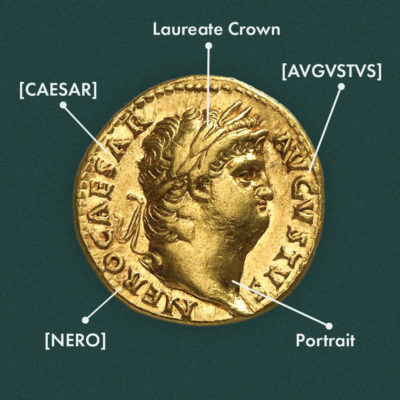
The Legend:
- [NERO], Nero, relating to emperor Nero. ‘Nero Caesar Augustus’.
- [CAESAR], Caesar. ‘Caesar’ paid tribute to the famous Roman statesman, and was a title adopted by every Roman Emperor.
- [AVGVSTVS], Augustus. ‘Augustus’ was a title which paid tribute to the first Roman Emperor, and became part of the titulature of every Roman Emperor.
Portraiture:
- The Portrait. Arguably the most important feature of the coin, the portrait promoted the emperor and helped make the piece a trusted unit of currency, backed by the Roman state.
- ‘Warts and All’. Despite Nero’s notoriety as a vain ruler, Roman Emperors of the Early Empire preferred to have themselves depicted much as they appeared in real life. The result is that, towards the end of his reign, we see Nero as the obese glutton that he was.
- Laureate Crown. The laurel wreath was an ancient symbol of victory, often associated with kingship. It was adopted as an icon of the Roman Emperor.
reverse
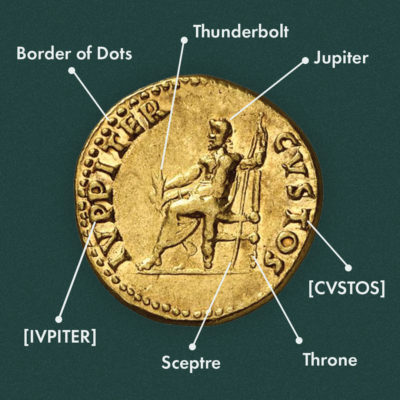
Legend:
- [IVPITER] Jupiter. Mythological God of the Sky who Romans believed oversaw all aspects of life.
- [CVSTOS] meaning to ‘custos’, translating in Latin to ‘Guardian’.
Design:
- A decorative border of dots is used to identify the outer limit of the die design, aka ‘beading‘.
- Portrait of Jupiter. Arguably the most important Roman God, Jupiter was an ideal choice to grace the coinage of a Roman Emperor, invoking the power of the King of the Gods.
- Throne and Sceptre – a must for any powerful leader.
- Thunderbolt – Jupiter was said to have struck down his enemies with bolts of lightning – similar (or derived from) the ancient Greek god, Zeus. The roman empire worshipped Zeus and depicted him on their coinage.
Kingdom of Thrace, Lysimachus, Gold Stater, c. 323-281 BC.
obverse
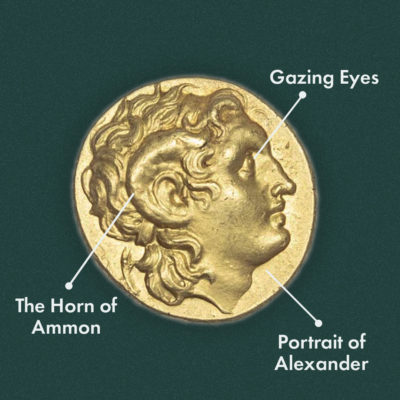
The Legend. This coin features no legend on the obverse, it is termed ‘anepigraphic’.
- Portrait of Alexander. Coins of Lysimachus depict the portrait of Alexander the Great, the renowned Macedonian King. This was an attempt to legitimise the Thracian king’s domain, which was once ruled by Alexander.
- The Horn of Ammon. The distinctive horn is a reference to Alexander’s belief that he was a son of the God, Ammon.
- Gazing Eyes. Alexander’s is depicted gazing upwards towards the heavens, his eyes wide open. This is a symbol of his divinity.
reverse
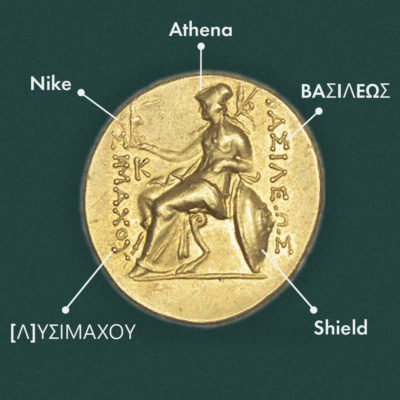
Inscriptions
- [Λ]ΥΣΙΜΑΧΟΥ is a Greek inscription meaning ‘Lysimachus‘.
- BAΣIΛEΩΣ meaning ‘King‘ therefore the coin reads ‘of King Lysimachus‘.
Design:
- Portrait of Athena. The Greek Goddess of wisdom and war appears seated on a throne and resting on a shield decorated with a lion’s head.
- Nike. Athena is depicted holding a small Nike, the symbol personification of Victory. This was a suitable symbol at a time when rulers, including Lysimachus, were sparring over the deceased Alexander’s enormous domain.
If you would like to find out more about ancient coins and what they mean, please feel free to contact our ancient coin specialist, Dominic Chorney by email. For further viewing, you can watch Dominic read an ancient coin with Henry Cole as part of the TV series ‘The Great British Treasure Hunt’.


